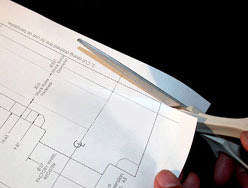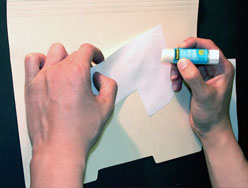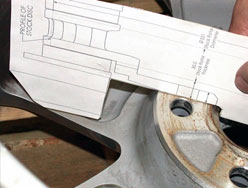D2 Big Brake Kit Wheel Fitment Check

It is crucial to check the vehicle and the parts on the vehicle to make sure that the brakes will fit.
Brakes are placed in a very confined space and big brake kits exist in spaces that were not previously occupied by parts. In this confined space D2 produces brakes that are larger than stock brakes to provide more performance.
Brakes exist in the space between the wheels and the hub on a vehicle. On the inboard side, there are suspension pieces. The diameter of the brakes can't exceed the inner diameter of the wheel used, and the inside spokes of the wheels limit how wide the brake calipers can be.
Space for the calipers varies by wheel design. Two wheels with the same offset, same diameter, and same width will yield two different fitments. One that does fit over the brakes, and one that does not. For that reason it is crucial to use the wheel fitment templates to check whether a wheel will fit over the brakes for your specific application.
To start, a general guideline is that D2 kits usually require the following:
- 286mm rotor (11.3") - minimum 15" wheel
- 304mm rotor (12") - minimum 16" wheel
- 330mm rotor (13") - minimum 17" wheel
- 356mm rotor (14") - minimum 18" wheel
- 380mm rotor (15") - minimum 19" wheel
- 400mm rotor (15.7") - minimum 20" wheel
- 421mm rotor (16.6") - minimum 21" wheel
Wheel fitment instructions
 |
 |
|
| 1. Print the drawing and check the horizontally and vertically dimensions to be sure it has printed to scale. Now cut the drawing just outside the dotted line. | 2. Take a stiffer piece of material such as a manila folder or carton. This will make the template easier to use. Finish by cutting directly along the dotted line. | |
 |
 |
|
| 3. Lay the template inside the wheel as shown | 4. Verify that edge of the caliper does not touch the rim or the spoke. A minimum of 2mm (0.080") is recommended. |
If there is interference, different wheels or a wheel spacer will be necessary. Use of a wheel spacer is at the discretion of the vehicle owner. Typically a properly made spacer of 2-3mm will not adversely effect the vehicle. Issues that must be addressed before utilizing a wheel spacer include, but are not limited to, fender clearance, proper wheel bolt or stud length, effect on vehicle handling, and centering of the wheel. Wheel fitment and the use of wheel spacers with our big brake upgrades is the responsibility of the customer.
Note that due to commonality of hats, rotors and caliper specifications between applications, the wheel fit chart used for your vehicle may be labeled for a different vehicle, i.e., a Nissan 300ZX rear uses the same fit chart as a Nissan 350Z rear. This does not mean the kits are the same, only that the disc and caliper are positioned the same relative to the wheel mounting surface.
Request a template
Please fill in the contact form below and we 'll sent you a copy of the template via email.
